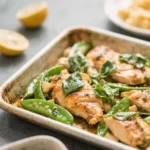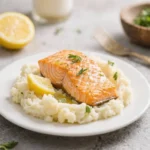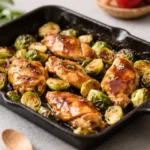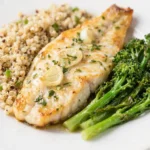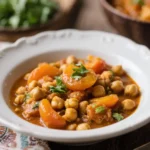One-Pan Baked Thai Basil Chicken with Snap Peas
If you’re craving bold Thai flavors without the fuss of constant stovetop stirring and multiple pots, this One-Pan Baked Thai Basil Chicken with Snap Peas is your new weeknight hero. This aromatic, savory dish brings together tender chicken, crisp-tender snap peas, and the unmistakable fragrance of fresh Thai basil, all baked to perfection on a single sheet pan. It’s an effortless fusion of convenience and authentic Southeast Asian taste, ideal for busy home cooks who don’t want to compromise on flavor or nutrition.
The History
Thai Basil Chicken, known as Kai Pad Krapow in Thailand, is one of the most beloved street food dishes across the country. Traditionally stir-fried in a blazing-hot wok with garlic, chilies, fish sauce, and a generous handful of holy basil (or sometimes Thai basil), it’s typically served over steamed jasmine rice with a fried egg on top. The dish showcases the balance of salty, spicy, sweet, and umami that defines Thai cuisine. While the classic version requires constant attention over high heat, modern adaptations—like this one-pan baked version—have made it more accessible for home kitchens worldwide. By using baking instead of stir-frying, we preserve much of the original flavor while significantly reducing prep time, cleanup, and the risk of overcooking. This evolution reflects how global palates are embracing traditional dishes with a contemporary twist, making them easier to recreate outside their native culinary environments.
Ingredients Breakdown
Every ingredient in this recipe plays a vital role in building layers of flavor, texture, and aroma:
- Chicken Breast or Thighs: Boneless, skinless chicken breasts offer lean protein, while thighs provide more juiciness and richness due to their higher fat content. Both work well, but thighs tend to stay more tender after baking.
- Fresh Thai Basil: Not to be confused with sweet Italian basil, Thai basil has a licorice-like aroma and holds up better under heat. It adds a floral, slightly spicy note essential to the dish’s authenticity.
- Snap Peas: These vibrant green legumes add color, crunch, and freshness. They cook quickly and retain a pleasant bite even after baking, balancing the softness of the chicken.
- Garlic: Minced fresh garlic delivers pungency and depth, forming the aromatic backbone of the dish.
- Red Chili (or Fresno Pepper): Adds heat and subtle fruitiness. You can adjust the amount based on spice tolerance.
- Fish Sauce: A staple in Thai cooking, fish sauce contributes saltiness and umami. Use a high-quality brand like Red Boat or Tiparos for best results.
- Soy Sauce or Tamari: Complements fish sauce with deeper soy flavor; tamari is gluten-free and slightly richer.
- Oyster Sauce: Adds sweetness and body, helping to create a glossy glaze when baked.
- Brown Sugar: Balances the salt and heat with a touch of caramelized sweetness.
- Lime Juice: Freshly squeezed lime juice brightens the entire dish, cutting through the richness and enhancing other flavors.
- Vegetable Oil or Avocado Oil: Helps distribute heat evenly during baking and prevents sticking.
- Toasted Sesame Oil (optional): Drizzled at the end for nutty complexity.
- Jasmine Rice (for serving): The classic pairing—fragrant, slightly sticky, and perfect for soaking up the flavorful juices.
- Fried Egg (optional garnish): For those seeking authenticity, a runny-yolk fried egg on top elevates the dish into a full meal experience.
Step-by-Step Recipe
- Preheat Oven & Prepare Pan: Preheat your oven to 400°F (200°C). Line a large rimmed baking sheet with parchment paper or aluminum foil for easy cleanup. Lightly grease the surface with oil.
- Prepare Ingredients: Dice the chicken into 1-inch cubes. Trim the ends off the snap peas if desired. Mince the garlic and slice the chili thinly (remove seeds for less heat). Chop the Thai basil leaves roughly, keeping them aside until the final step.
- Make the Sauce: In a small bowl, whisk together 3 tablespoons fish sauce, 2 tablespoons soy sauce, 2 tablespoons oyster sauce, 1 tablespoon brown sugar, juice of half a lime (about 1–1.5 tablespoons), 1 teaspoon sesame oil (if using), and 1 tablespoon water to help dissolve the sugar. Set aside.
- Toss Chicken and Veggies: In a large mixing bowl, combine the diced chicken, snap peas, minced garlic, and sliced chili. Pour about two-thirds of the sauce over the mixture and toss thoroughly to coat every piece. Reserve the remaining sauce for basting.
- Spread on Pan: Transfer the marinated chicken and vegetables onto the prepared baking sheet in a single even layer. Avoid overcrowding to ensure proper roasting rather than steaming.
- Bake First Stage: Place in the preheated oven and bake for 15 minutes. This allows the chicken to start cooking through and the edges to caramelize slightly.
- Baste and Stir: Remove the pan from the oven. Use a spatula to gently stir and flip the contents. Brush or drizzle with the remaining sauce to boost flavor and moisture.
- Second Bake: Return to the oven and bake for another 8–10 minutes, or until the chicken is fully cooked (internal temperature reaches 165°F / 74°C) and the snap peas are tender-crisp with lightly browned edges.
- Add Basil: Immediately upon removing from the oven, sprinkle the chopped Thai basil over the hot mixture. Toss quickly so the residual heat wilts the leaves just enough to release their fragrance without turning them black.
- Serve: Spoon the sizzling mixture over warm jasmine rice. Optionally top each serving with a fried egg, a sprinkle of red pepper flakes, or extra basil leaves. Serve with lime wedges on the side for squeezing.
Tips
- Uniform Cutting: Cut the chicken and snap peas into similar sizes to ensure even cooking. Uneven pieces may result in some being overcooked while others remain underdone.
- Don’t Skip the Resting Sauce: Adding part of the sauce before baking infuses flavor deep into the ingredients, while reserving some for basting keeps everything moist and intensifies the glaze.
- Use Fresh Garlic: Pre-minced jarred garlic lacks the punch and freshness needed for authentic flavor. Always go for freshly minced cloves.
- High-Quality Fish Sauce: Cheap or overly fishy brands can overpower the dish. Opt for clear, amber-hued fish sauces with balanced salinity.
- Watch the Basil Timing: Never bake Thai basil—it turns bitter and loses its essence. Always fold it in after baking, using the pan’s heat to gently wilt it.
- Avoid Overbaking: Chicken breast dries out quickly. If using breast meat, check at 20 minutes total baking time. Thighs are more forgiving and can handle an extra few minutes.
- Parchment Paper Is Key: Prevents sticking and makes cleanup nearly effortless. Foil works too, but parchment gives a non-stick advantage without risking chemical leaching.
- Crispier Edges? For more caramelization, switch the oven to broil for the last 2–3 minutes (watch closely to avoid burning).
Variations and Customizations
This recipe is highly adaptable to dietary preferences, seasonal produce, and pantry availability:
- Protein Swap: Replace chicken with thinly sliced beef (like sirloin), pork tenderloin, shrimp, or tofu for a vegetarian option. Adjust baking times accordingly—shrimp needs only 8–10 minutes total, tofu benefits from pre-baking to firm up.
- Veggie Additions: Feel free to include bell peppers, zucchini slices, baby corn, mushrooms, or broccoli florets. Just keep dense veggies smaller or par-cook them slightly to match cooking times.
- Low-Sodium Version: Use reduced-sodium soy sauce and fish sauce, increase lime juice and garlic for brightness, and rely on fresh herbs and chili for flavor depth.
- Gluten-Free Option: Substitute regular soy sauce with tamari or a certified gluten-free soy sauce alternative.
- Spice Level Control: Omit chilies entirely for mild flavor, or add bird’s eye chilies for extreme heat. Serrano peppers also work well for medium spice.
- Dry Version (Closer to Stir-Fry): Reduce the sauce by half and thicken it with 1/2 teaspoon cornstarch mixed in water before basting for a stickier glaze.
- Meal Prep Friendly: Double the batch and store portions in airtight containers for up to 4 days. Reheat in a skillet or microwave, adding a splash of water to refresh moisture.
- Noodle Bowl Twist: Serve over rice noodles or glass noodles instead of rice for a different texture profile.
Health Considerations and Nutritional Value
This One-Pan Baked Thai Basil Chicken with Snap Peas isn’t just delicious—it’s also a nutritionally balanced meal that supports a healthy lifestyle.
Nutritional Highlights (per serving, approx. 1 cup chicken + veggies, without rice):
- Calories: ~280–320 kcal
- Protein: 30–35g – Excellent source from lean chicken, supporting muscle repair and satiety.
- Fat: 10–12g – Mostly unsaturated fats from oils and natural sources; minimal saturated fat if chicken breast is used.
- Carbohydrates: 14–16g – Primarily from snap peas, brown sugar, and sauces. Fiber content is ~4g per serving thanks to snap peas.
- Sodium: ~900–1100mg – Moderate, mostly from fish and soy sauces. Can be reduced by using low-sodium versions.
- Vitamins & Minerals: Rich in vitamin C (snap peas, lime), vitamin K (greens), selenium (chicken), and antioxidants from garlic and chili.
Health Benefits:
- High Protein, Low Carb Option: Ideal for those following high-protein or moderate-low carb diets.
- Antioxidant-Rich: Garlic contains allicin, known for immune support; chilies have capsaicin, which may boost metabolism.
- Heart-Healthy Fats: When using avocado or olive oil sparingly, the fat profile supports cardiovascular wellness.
- Digestive Support: Fiber from snap peas aids digestion, while fermented fish sauce may contribute beneficial microbes (though not probiotic-rich like yogurt).
Considerations:
- Those with hypertension should monitor sodium intake and consider lower-salt alternatives.
- Fish sauce is not suitable for shellfish allergies or strict vegetarians/vegans. Use a vegan “fish” sauce substitute (e.g., made from seaweed and soy) for plant-based diets.
- For keto dieters, reduce or omit brown sugar and serve over cauliflower rice to keep carbs low.
Ingredients
- 1.5 lbs (680g) boneless, skinless chicken breasts or thighs, cut into 1-inch cubes
- 2 cups fresh snap peas, trimmed
- 1/2 cup loosely packed fresh Thai basil leaves, chopped (plus extra for garnish)
- 4 cloves garlic, minced
- 1–2 red chilies or Fresno peppers, thinly sliced (adjust to taste)
- 3 tbsp fish sauce (preferably premium quality)
- 2 tbsp soy sauce or tamari (gluten-free if needed)
- 2 tbsp oyster sauce (use vegetarian oyster sauce for vegan option)
- 1 tbsp packed brown sugar (or coconut sugar)
- 1.5 tbsp fresh lime juice (from about 1/2 lime)
- 1 tbsp vegetable or avocado oil
- 1 tsp toasted sesame oil (optional)
- 1 tbsp water
- Cooked jasmine rice, for serving
- Fried eggs (optional, for topping)
- Lime wedges, for serving
Directions
- Preheat oven to 400°F (200°C). Line a large baking sheet with parchment paper and lightly grease with oil.
- In a small bowl, whisk together fish sauce, soy sauce, oyster sauce, brown sugar, lime juice, sesame oil (if using), and water until sugar dissolves. Set aside.
- In a large bowl, combine chicken cubes, snap peas, minced garlic, and sliced chilies. Pour 2/3 of the sauce mixture over and toss to coat evenly. Reserve the remaining sauce.
- Spread the mixture in a single layer on the prepared baking sheet.
- Bake for 15 minutes, then remove from oven and stir/flip the contents. Drizzle with the remaining sauce.
- Return to oven and bake for another 8–10 minutes, until chicken is cooked through and snap peas are tender-crisp with slight browning.
- Immediately sprinkle chopped Thai basil over the hot mixture and toss gently to wilt the leaves.
- Serve hot over jasmine rice, topped with a fried egg if desired, with lime wedges on the side.
FAQ
Can I use dried basil instead of fresh Thai basil?
No, dried basil won’t provide the same aromatic quality or texture. If you can’t find Thai basil, sweet basil is a distant second choice, but holy basil (if available) is closest to traditional flavor.
Is this recipe gluten-free?
Yes, if you use tamari or a certified gluten-free soy sauce and ensure your oyster sauce is gluten-free (or use a mushroom-based vegetarian alternative).
Can I make this ahead of time?
You can prep the sauce and chop ingredients up to 24 hours in advance. Store separately in the fridge. Assemble and bake just before serving for best texture.
How do I store leftovers?
Cool completely and store in an airtight container in the refrigerator for up to 4 days. Reheat in a skillet over medium heat or in the microwave with a splash of water.
Why didn’t my chicken brown?
Baking doesn’t sear like a stovetop wok. For more browning, increase oven temperature to 425°F or broil for the last 2–3 minutes. Make sure the pan isn’t overcrowded.
Can I freeze this dish?
Yes, though snap peas may soften upon thawing. Freeze without basil; add fresh basil when reheating. Best consumed within 2 months.
What can I serve with this besides rice?
Try cauliflower rice, quinoa, rice noodles, or even lettuce wraps for a low-carb option.
Summary
One-Pan Baked Thai Basil Chicken with Snap Peas delivers bold, restaurant-quality Thai flavors with minimal effort and cleanup. Packed with protein, vibrant veggies, and aromatic herbs, it’s a wholesome, satisfying meal ready in under 30 minutes.

